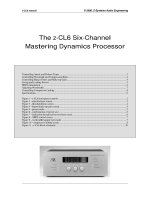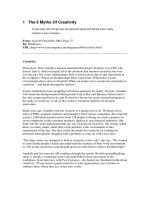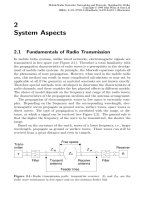Tài liệu The 6.270 Robot Builder''''s Guide P2 doc
Bạn đang xem bản rút gọn của tài liệu. Xem và tải ngay bản đầy đủ của tài liệu tại đây (218.75 KB, 20 trang )
A compound is different than a simple mixture of elements. If hydrogen and oxy-
gen are mixed, the result is a colorless, odorless gas, just like either element is a gas
separately. A spark, however, will cause the molecules to join together; this will liber-
ate energy in the form of light and heat. Under the right conditions, there will be a vi-
olent explosion, because the two elements join eagerly. Water is chemically illustrated
in Fig. 1-3.
10 Basic physical concepts
Compounds often, but not always, appear greatly different from any of the ele-
ments that make them up. At room temperature and pressure, both hydrogen and oxy-
gen are gases. But water under the same conditions is a liquid. If it gets a few tens of
degrees colder, water turns solid at standard pressure. If it gets hot enough, water be-
comes a gas, odorless and colorless, just like hydrogen or oxygen.
Another common example of a compound is rust. This forms when iron joins with
oxygen. While iron is a dull gray solid and oxygen is a gas, rust is a maroon-red or
brownish powder, completely unlike either of the elements from which it is formed.
Molecules
When atoms of elements join together to form a compound, the resulting particles
are molecules. Figure 1-3 is an example of a molecule of water, consisting of three
atoms put together.
The natural form of an element is also known as its molecule. Oxygen tends to occur
in pairs most of the time in the earth’s atmosphere. Thus, an oxygen molecule is some-
times denoted by the symbol O
2
. The “O” represents oxygen, and the subscript 2 indi-
cates that there are two atoms per molecule. The water molecule is symbolized H
2
O,
because there are two atoms of hydrogen and one atom of oxygen in each molecule.
1-3 Simplified diagram of a water molecule.
Sometimes oxygen atoms are by themselves; then we denote the molecule simply as O.
Sometimes there are three atoms of oxygen grouped together. This is the gas called
ozone, that has received much attention lately in environmental news. It is written O
3
.
All matter, whether it is solid, liquid, or gas, is made of molecules. These particles
are always moving. The speed with which they move depends on the temperature. The
hotter the temperature, the more rapidly the molecules move around. In a solid, the
molecules are interlocked in a sort of rigid pattern, although they vibrate continuously
(Fig. 1-4A). In a liquid, they slither and slide around (Fig. 1-4B). In a gas, they are lit-
erally whizzing all over the place, bumping into each other and into solids and liquids
adjacent to the gas (Fig. 1-4C).
Conductors
In some materials, electrons move easily from atom to atom. In others, the electrons
move with difficulty. And in some materials, it is almost impossible to get them to move.
An electrical conductor is a substance in which the electrons are mobile.
The best conductor at room temperature is pure elemental silver. Copper and alu-
minum are also excellent electrical conductors. Iron, steel, and various other metals are
fair to good conductors of electricity.
In most electrical circuits and systems, copper or aluminum wire is used. Silver is
impractical because of its high cost.
Some liquids are good electrical conductors. Mercury is one example. Salt water is
a fair conductor.
Gases are, in general, poor conductors of electricity. This is because the atoms or
molecules are usually too far apart to allow a free exchange of electrons. But if a gas be-
comes ionized, it is a fair conductor of electricity.
Electrons in a conductor do not move in a steady stream, like molecules of water
through a garden hose. Instead, they are passed from one atom to another right next to
it (Fig. 1-5). This happens to countless atoms all the time. As a result, literally trillions
of electrons pass a given point each second in a typical electrical circuit.
You might imagine a long line of people, each one constantly passing a ball to the
neighbor on the right. If there are plenty of balls all along the line, and if everyone keeps
passing balls along as they come, the result will be a steady stream of balls moving along
the line. This represents a good conductor.
If the people become tired or lazy, and do not feel much like passing the balls along,
the rate of flow will decrease. The conductor is no longer very good.
Insulators
If the people refuse to pass balls along the line in the previous example, the line repre-
sents an electrical insulator. Such substances prevent electrical currents from flowing,
except possibly in very small amounts.
Most gases are good electrical insulators. Glass, dry wood, paper, and plastics are
other examples. Pure water is a good electrical insulator, although it conducts some
current with even the slightest impurity. Metal oxides can be good insulators, even
though the metal in pure form is a good conductor.
Insulators 11
12 Basic physical concepts
1-4 At A, simplified rendition
of molecules in a solid; at
B, in a liquid; at C, in a
gas. The molecules don’t
shrink in the gas. They
are shown smaller
because of the much
larger spaces between
them.
Electrical insulators can be forced to carry current. Ionization can take place; when
electrons are stripped away from their atoms, they have no choice but to move along.
Sometimes an insulating material gets charred, or melts down, or gets perforated by a
spark. Then its insulating properties are lost, and some electrons flow.
An insulating material is sometimes called a dielectric. This term arises from the
fact that it keeps electrical charges apart, preventing the flow of electrons that would
equalize a charge difference between two places. Excellent insulating materials can be
used to advantage in certain electrical components such as capacitors, where it is im-
portant that electrons not flow.
Porcelain or glass can be used in electrical systems to keep short circuits from oc-
curring. These devices, called insulators, come in various shapes and sizes for different
applications. You can see them on high-voltage utility poles and towers. They hold the
wire up without running the risk of a short circuit with the tower or a slow discharge
through a wet wooden pole.
Resistors
Some substances, such as carbon, conduct electricity fairly well but not really well. The
conductivity can be changed by adding impurities like clay to a carbon paste, or by wind-
ing a thin wire into a coil. Electrical components made in this way are called resistors. They
are important in electronic circuits because they allow for the control of current flow.
Resistors can be manufactured to have exact characteristics. Imagine telling each
person in the line that they must pass a certain number of balls per minute. This is anal-
ogous to creating a resistor with a certain value of electrical resistance.
The better a resistor conducts, the lower its resistance; the worse it conducts, the
higher the resistance.
Resistors 13
1-5 In a conductor, electrons are passed from atom to atom.
Electrical resistance is measured in units called ohms. The higher the value in
ohms, the greater the resistance, and the more difficult it becomes for current to flow.
For wires, the resistance is sometimes specified in terms of ohms per foot or ohms per
kilometer. In an electrical system, it is usually desirable to have as low a resistance, or
ohmic value, as possible. This is because resistance converts electrical energy into heat.
Thick wires and high voltages reduce this resistance loss in long-distance electrical
lines. This is why such gigantic towers, with dangerous voltages, are necessary in large
utility systems.
Semiconductors
In a semiconductor, electrons flow, but not as well as they do in a conductor. You might
imagine the people in the line being lazy and not too eager to pass the balls along. Some
semiconductors carry electrons almost as well as good electrical conductors like copper
or aluminum; others are almost as bad as insulating materials. The people might be just
a little sluggish, or they might be almost asleep.
Semiconductors are not exactly the same as resistors. In a semiconductor, the ma-
terial is treated so that it has very special properties.
The semiconductors include certain substances, such as silicon, selenium, or gal-
lium, that have been “doped” by the addition of impurities like indium or antimony.
Perhaps you have heard of such things as gallium arsenide, metal oxides, or silicon
rectifiers. Electrical conduction in these materials is always a result of the motion
of electrons. However, this can be a quite peculiar movement, and sometimes engi-
neers speak of the movement of holes rather than electrons. A hole is a shortage of an
electron—you might think of it as a positive ion—and it moves along in a direction
opposite to the flow of electrons (Fig. 1-6).
14 Basic physical concepts
1-6 Holes move in the opposite direction from electrons in a semiconducting material.
When most of the charge carriers are electrons, the semiconductor is called
N-type, because electrons are negatively charged. When most of the charge carriers are
holes, the semiconducting material is known as P-type because holes have a positive
electric charge. But P-type material does pass some electrons, and N-type material car-
ries some holes. In a semiconductor, the more abundant type of charge carrier is called
the majority carrier. The less abundant kind is known as the minority carrier.
Semiconductors are used in diodes, transistors, and integrated circuits in almost
limitless variety. These substances are what make it possible for you to have a computer
in a briefcase. That notebook computer, if it used vacuum tubes, would occupy a sky-
scraper, because it has billions of electronic components. It would also need its own
power plant, and would cost thousands of dollars in electric bills every day. But the cir-
cuits are etched microscopically onto semiconducting wafers, greatly reducing the size
and power requirements.
Current
Whenever there is movement of charge carriers in a substance, there is an electric
current. Current is measured in terms of the number of electrons or holes passing a
single point in one second.
Usually, a great many charge carriers go past any given point in one second, even if
the current is small. In a household electric circuit, a 100-watt light bulb draws a cur-
rent of about six quintillion (6 followed by 18 zeroes) charge carriers per second.
Even the smallest mini-bulb carries quadrillions (numbers followed by 15 zeroes) of
charge carriers every second. It is ridiculous to speak of a current in terms of charge
carriers per second, so usually it is measured in coulombs per second instead. A
coulomb is equal to approximately 6,240,000,000,000,000,000 electrons or holes. A cur-
rent of one coulomb per second is called an ampere, and this is the standard unit of
electric current. A 100-watt bulb in your desk lamp draws about one ampere of current.
When a current flows through a resistance—and this is always the case because
even the best conductors have resistance—heat is generated. Sometimes light and
other forms of energy are emitted as well. A light bulb is deliberately designed so that
the resistance causes visible light to be generated. Even the best incandescent lamp is
inefficient, creating more heat than light energy. Fluorescent lamps are better. They
produce more light for a given amount of current. Or, to put it another way, they need
less current to give off a certain amount of light.
Electric current flows very fast through any conductor, resistor, or semiconductor.
In fact, for most practical purposes you can consider the speed of current to be the
same as the speed of light: 186,000 miles per second. Actually, it is a little less.
Static electricity
Charge carriers, particularly electrons, can build up, or become deficient, on things
without flowing anywhere. You’ve probably experienced this when walking on a car-
peted floor during the winter, or in a place where the humidity was very low. An excess
or shortage of electrons is created on and in your body. You acquire a charge of static
Static electricity 15
electricity
.
It’s called “static” because it doesn’t go anywhere. You don’t feel this until you
touch some metallic object that is connected to earth ground or to some large fixture;
but then there is a discharge, accompanied by a spark that might well startle you. It is
the current, during this discharge, that causes the sensation that might make you jump.
If you were to become much more charged, your hair would stand on end, because
every hair would repel every other. Like charges are caused either by an excess or a de-
ficiency of electrons; they repel. The spark might jump an inch, two inches, or even six
inches. Then it would more than startle you; you could get hurt. This doesn’t happen
with ordinary carpet and shoes, fortunately. But a device called a Van de Graaff gen-
erator, found in some high school physics labs, can cause a spark this large (Fig. 1-7).
You have to be careful when using this device for physics experiments.
16 Basic physical concepts
1-7
Simple diagram of a Van de Graaff generator for creating
large static charges.
In the extreme, lightning occurs between clouds, and between clouds and ground
in the earth’s atmosphere. This spark is just a greatly magnified version of the little
spark you get after shuffling around on a carpet. Until the spark occurs, there is a static
charge in the clouds, between different clouds or parts of a cloud, and the ground. In
Fig. 1-8, cloud-to-cloud (A) and cloud-to-ground (B) static buildups are shown. In the
case at B, the positive charge in the earth follows along beneath the thunderstorm cloud
like a shadow as the storm is blown along by the prevailing winds.
The current in a lightning stroke is usually several tens of thousands, or hundreds
of thousands, of amperes. But it takes place only for a fraction of a second. Still, many
coulombs of charge are displaced in a single bolt of lightning.
Electromotive force
Current can only flow if it gets a “push.” This might be caused by a buildup of static elec-
tric charges, as in the case of a lightning stroke. When the charge builds up, with posi-
tive polarity (shortage of electrons) in one place and negative polarity (excess of elec-
trons) in another place, a powerful electromotive force exists. It is often abbreviated
EMF. This force is measured in units called volts.
Ordinary household electricity has an effective voltage of between 110 and 130;
usually it is about 117. A car battery has an EMF of 12 volts (six volts in some older sys-
tems). The static charge that you acquire when walking on a carpet with hard-soled
shoes is often several thousand volts. Before a discharge of lightning, many millions of
volts exist.
An EMF of one volt, across a resistance of one ohm, will cause a current of one ampere
to flow. This is a classic relationship in electricity, and is stated generally as Ohm’s
Electromotive force 17
1-8 Cloud-to-cloud (A) and cloud-to-ground (B) charge buildup can both occur in a single
thunderstorm.









